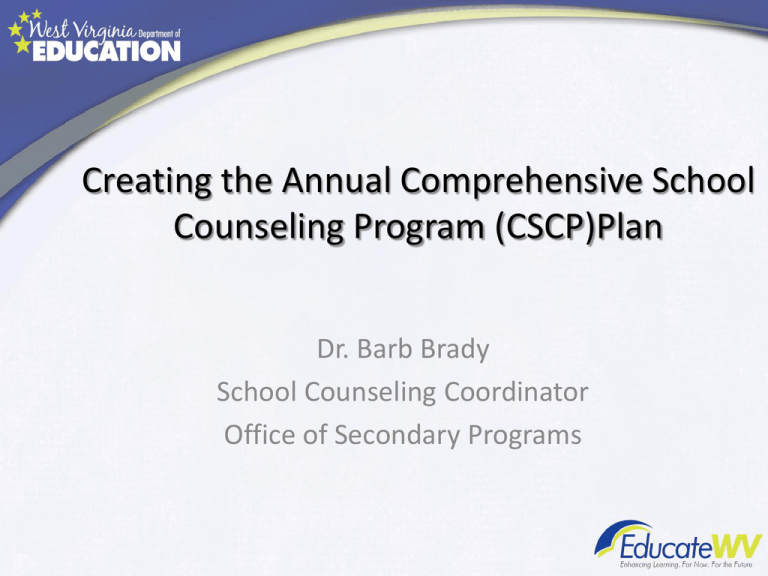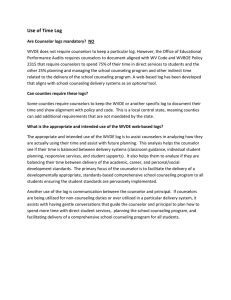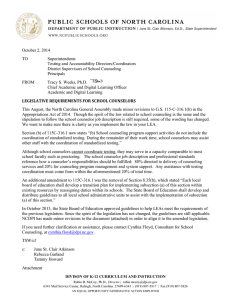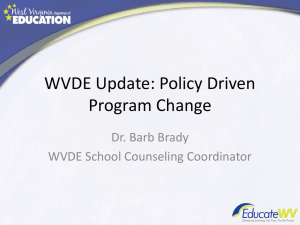Creating the Annual Comprehensive School Counseling Program (CSCP)Plan Dr. Barb Brady
advertisement

Creating the Annual Comprehensive School Counseling Program (CSCP)Plan Dr. Barb Brady School Counseling Coordinator Office of Secondary Programs CSCP Plan Considerations Program Completeness (Program Audit) State Model Alignment o 3-Tier Model Assessment o Delivery System Appraisal (using audit) School Counselor Performance Standards Evaluation goals Student, school & community data WV Student Success Standards (grade-level priorities) Self Reflection includes assessing program completeness to guide setting annual program growth goals. Overarching Standards Performance level Rubrics • Standards (5) – Broad statements/ constructs • Functions (19)– Describes the important functional or procedural parts of the standard • Indicators (50)– Further delineate the functions into observable measures WV Professional School Counselor Standards Standard 1: Program Planning, Design and Management Standard 2: Program Delivery Standard 3: Data Driven Accountability and Program Evaluation Standard 4: Leadership and Advocacy Standard 5: Professional Growth and Responsibilities Standards also found in WVBE 5100: Approval of Educational Personnel Preparation Programs http://wvde.state.wv.us/counselors/WVSchoolCounselorPerformanceStandards.html Standards also Found in WVBE 5100: Approval of Educational Personnel Preparation Programs Provides detailed school counseling program framework and details the role of the WV school counselor WV School Counseling Model and Policy 2315 11 Standard Elements align with WV’s Multi-tiered Prevention-based System Tertiary Prevention: • • • • Specialized Individualized Systems for Students with High-Risk Community/School Partnerships Secondary Prevention: • • Specialized Groups Systems for Students with At Risk Behavior Primary Prevention: • School/Classroom-Wide for Students, Staff and Families [advisor-advisee and developmental guidance] As per WVBE Policy 5310: Performance Evaluation of School Personnel… School Counselors are under the new evaluation system This guide details the evaluation components and process. Link is found on front page of WVDE school counseling website Sample Rubric Self Reflection is guided by examining one’s own performance level in each of the 13 standard elements. SMART Goals S - Specific • The outcome is clear. M - Measurable • You can count it or see it. A - Achievable • You have what you need to be able to do it. R – Results-oriented • It is aligned with school/district goals. T - Timed • A specific date has been set. Counselor Jump Screen: On this screen Click on “Add a Goal” Action Plans: Evaluation Website Once goals are set, counselors will develop action steps to guide goal attainment, identifying resources needed to achieve goal. Online evaluation system (form in evaluation guide) will aid counselors in the development of the student impact goal. Job Description Alignment • Are county/school job descriptions aligned with the WV School Counseling Model and WV Performance Descriptors? – Model Job descriptions have been created to align with new standards. – Appendix A in Model booklet » Overarching job descriptions » Programmatic level – recommendations » Institutional Ed./ Vocational Technical Schools • Job descriptions should support counselors being able to be ‘accomplished’. Data-driven Goals (Process, Perception, Results) – – – – – Needs assessments Student, staff and family forums Culture surveys Informal conversations Etc. Data-driven Goals (Process, Perception, Results) – What’s in place within each tier/delivery system? – What’s missing? What will you improve this year? • Integrated Delivery of WV Student Success Standards – Systemic process addressing all standards within programmatic level • Personalized Student Planning – Parental engagement in academic planning – early learning grades – PEP Process (alignment with model, parental engagement) • Responsive Services – Group counseling (#, types, who participates) – Referral process – Crisis Plan • Student Supports Expanded school mental health Advising/mentoring Positive behavior support programs Crisis Prevention/Response system Tutoring/credit recovery Student leadership, etc Data-driven Goals (Process, Perception, Results) – What’s in place within each tier/delivery system? – What’s missing? What will you improve this year? – How do you communicate with stakeholders? Assessment and Documentation Tools School Counseling Program Audit 3-tier Assessment tool Program evaluation tools for specific programs (advisory, PBIS, Bullying Prevention, etc.) # of students, staff, parents participating PEP Plans Curriculum maps Public Relations Tools (website, newsletter, program report card, etc.) Data-driven Goals (Process, Perception, Results) – Student and School Data • • • • • • • • • • Discipline Attendance Grades Assessment data PEP completion rates Retention/dropout/graduation rates Parental engagement FAFSA completion rates Culture survey Etc. What does the current data tell us? How are students different as a result of the school counseling program? Student Impact Goal – Community data • Disaster • Kids count (poverty rates, employment, domestic violence, educational attainment levels, Juvenile delinquency, etc. ) • Resources http://wvde.state.wv.us/counselors Forms are located on the front page of the school counseling website (State Model Implementation Tools) Can be duplicated when addressing more than one goal in a standard. Dr. Barb Brady bashcraft@access.k12.wv.us http://wvde.state.wv.us/counselors/




